In this article, we interview Bill Elrick, the executive director of the California Fuel Cell Partnership.
In our conversation with Bill, we discuss:
- The key role government policies play in signalling private investment
- How other regions can learn from California’s success with zero-emission technologies
- Key projects the California Fuel Cell Partnership is currently working on
- And much more
Let’s dive into our interview with Bill Elrick!
What is your area of expertise and what are you passionate about?
 I started in alternative fuels about 25 years ago when battery electric vehicles first started to hit the market. And I've been working on electrification ever since.
I started in alternative fuels about 25 years ago when battery electric vehicles first started to hit the market. And I've been working on electrification ever since.
An area where I’ve really focused on is that nexus of public-private partnership.
This is a big transformational effort which requires such a diverse set of stakeholders, and I've enjoyed trying to get the most out of everyone to get us towards those common goals.
What’s most exciting is, every day I see a greater potential and opportunity for hydrogen and electrification —not just in transportation, but in so many other applications.
What is the California Fuel Cell Partnership and what is its mission?
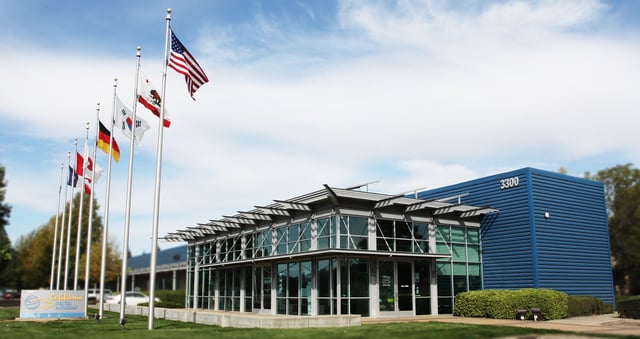
The California Fuel Cell Partnership is an industry-government collaboration. Our aim has always been to build and expand the market for fuel cell electric cars, buses and trucks.
Our overall vision is to create a cleaner, more energy-diverse future, and do that with no-compromise zero-emission vehicles. We've been around for 20 years, starting with the very early R&D efforts, through to the demonstrations, and all the way to the first commercial products just a couple of years ago.
And I always like to point out that while we focus on hydrogen and fuel cell vehicles, many of our members—government and industry—also focus on other electric drive technology. We think it's very important and very necessary that both technologies succeed in order to reach our goals.
What is your vision for hydrogen and zero-emission heavy duty mobility?
The great thing about hydrogen and the heavy duty space is hydrogen can provide a one-to-one replacement for the existing heavy-duty applications with a zero-emission vehicle.
And this sector is so important as far as fuel use, air quality, and global warming impacts that we need to aggressively implement this technology as quickly as possible.
What are some key challenges we need to overcome to achieve the deployment of fuel cell buses and trucks at a large scale?
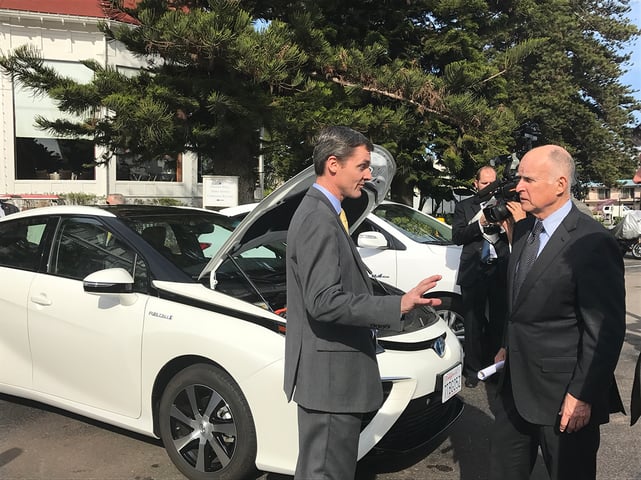 Bill Elrick with former California Governor Jerry Brown in San Diego at the Western Governors Association in 2016.
Bill Elrick with former California Governor Jerry Brown in San Diego at the Western Governors Association in 2016.
First and foremost, and not particular to just heavy-duty, is setting the stage with proper government policies and a policy environment that then signals and encourages greater private investment. Because both of those things together are what we need to scale up the market and that creates that opportunity.
The challenge is getting everyone to work together because both public and private stakeholders are needed to do this.
So, in these early years, we need to look at that policy investment in order to de-risk the environment so businesses are willing to make those long-term investments and achieve scale as quickly as possible. Because hydrogen at scale brings great value and benefit to all the stakeholders.
But getting there is the challenge, and the longer it takes to get there, the more it takes us in resources of time, expenditures, and so much more.
What is the impact of regulations like the Advanced Clean Truck ruling proposed by the California Air and Resources Board? What else is needed from a regulatory perspective to advance the technology?
The Advanced Clean Truck Rule gives us that momentum and ability to look into the future and put a realistic plan in place.
So, now with this long term consistency and technology neutrality, industry can plan out for those investments. They can build up the supply chain. They can work on their end of this, which really is to create a market.
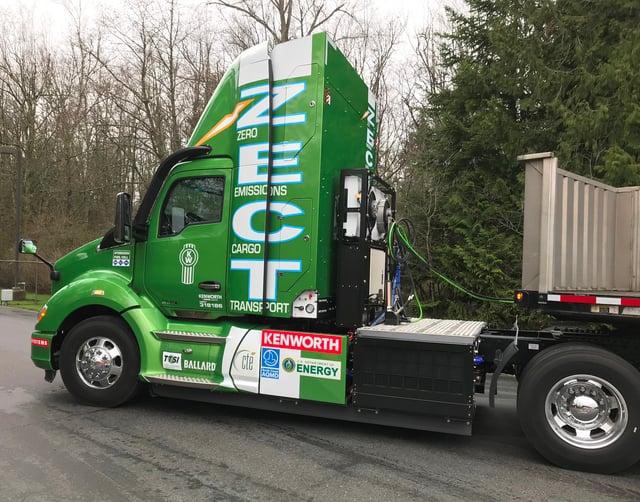
Kenworth’s hybrid battery-fuel cell Class 8 drayage truck haul loads at Southern California ports
So this regulation is a great example of setting a target that industry can then work towards. If we didn't have that target or if we have that target shifting around, that type of uncertainty is really one of the worst things for business overall—especially if you're trying to deploy a new technology.
What do you think other regions can learn from California in order to accelerate the deployment of fuel cell technologies?
California is definitely unique for its policy aggressiveness and its strong stance regarding resources dedicated to ZEV technologies and other activities that further state environmental and sustainability goals.
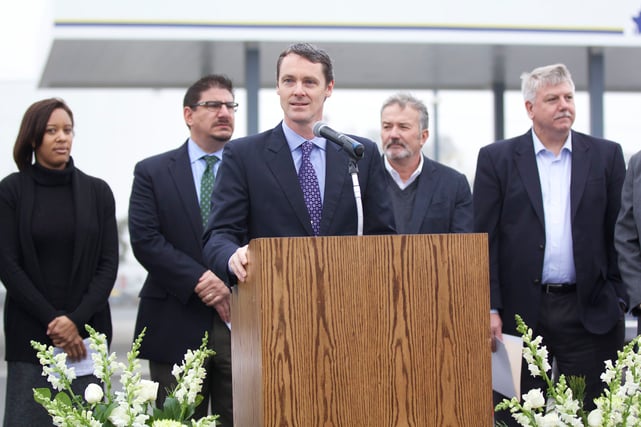 Bill Elrick at the celebration of the first public hydrogen fueling station in the US, opening in West Sacramento in 2013.
Bill Elrick at the celebration of the first public hydrogen fueling station in the US, opening in West Sacramento in 2013.
And we know other states may not have the same sort of resources or capabilities, but that's part of why we do what we do, so that when it does get to the point that other states are really excited and interested in this, we've done everything to help bring the technology to market, lower the cost and make it easier for them.
So the first bit of advice I give everyone is to really look at what we've done. And we've done a lot of the things well, but we've done some other things that, looking back, we would have done differently.
And each state, region, and country is going to take their resources, their insights and abilities, and they're going to apply their approach to it, even if they look to California for guidance. I'm hoping they'll see some of the successes and stumbles we’ve had along the way and be able to get there faster.
We have a great set of policies here that can help us reach several long term objectives. Plus we have allocated resources to achieve the objective.
And then one of the key tenets all along, especially with hydrogen and fuel cells, has been the collaboration of public and private sectors. Neither government nor industry can reach their goals by themselves in the early years.
So I think one of the key lessons learned is to build a strong coalition that can work together and weather the hard parts, because it is hard to develop a new market like this.
What are some of the activities of the California Fuel Cell Partnership?
We’re engaged in a number of activities that advance fuel cell cars, buses, and trucks further along the commercial path, beyond our core task of keeping our diverse members engaged on common issues and talking with each other.
 For example, when we knew the retail products were about ready for release a decade ago we set about as a group to answer the question of “How do we launch the California commercial market?”.
For example, when we knew the retail products were about ready for release a decade ago we set about as a group to answer the question of “How do we launch the California commercial market?”.
After we worked together on the analysis, opportunities, and challenges we ended up publishing “A California Roadmap” to give everyone a guiding light on how to roll out the initial station network in California.
As the California market has been successfully launched and we started to look at the need to accelerate rollout and reach a sustainable market, we published “The California Fuel Cell Revolution” to answer the question of when and what does the tipping point look like for a sustainable commercial market.
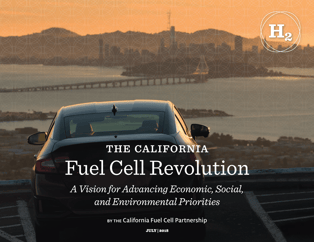
This document is guiding us today towards establishing a network of 1,000 hydrogen stations to make it possible for a cost-competitive, thriving hydrogen fuel cell vehicle market in California.
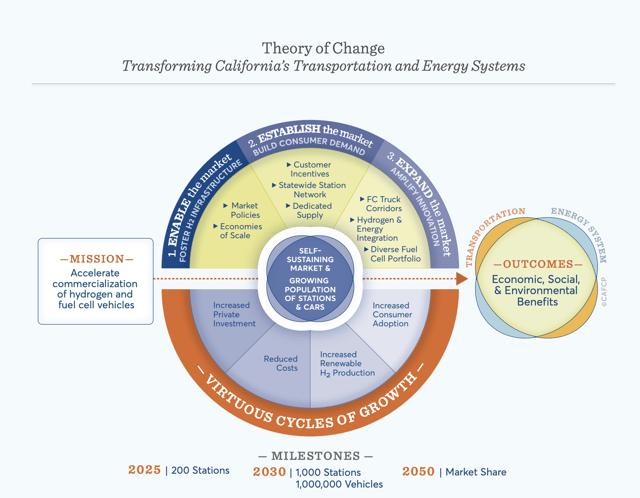
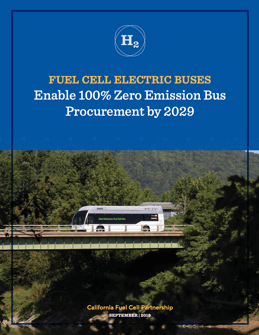 We’ve done similar work for heavy-duty applications as well, having published a second fuel cell electric bus roadmap last year that outlines essential actions and targets to transition the state’s transit fleets to zero emission hydrogen fuel cell buses.
We’ve done similar work for heavy-duty applications as well, having published a second fuel cell electric bus roadmap last year that outlines essential actions and targets to transition the state’s transit fleets to zero emission hydrogen fuel cell buses.
Our members and staff are working now on a new strategy document for fuel cell electric trucks, and we hope to publish that later this year.
Another activity we have undertaken is providing updates on the developing retail market for FCV drivers and other stakeholders.
Our Station Operational Status System, or SOSS, is an online and mobile app that provides drivers with near real time updates on station availability and access, and are currently undergoing a review of enhancements to make it even more valuable to FCV drivers.
We also track station development progress in the station map page on our website, providing similar station availability status as well as location, hours, and other relevant data. And I can’t forget to mention our strong social media program, including regular webinars, where we provide updates on vehicle and station rollout and relevant market activities.
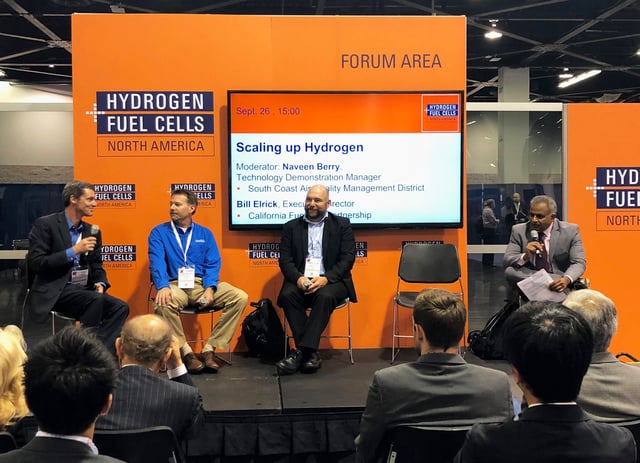
Bill Elrick at Hydrogen Fuel Cells North America in 2018.
Finally, we’re out educating and creating awareness and support among decision makers and officials on the benefits and value of hydrogen and fuel cells, helping them understand their support helps them achieve many of their goals and objectives.
Hydrogen and fuel cells are the mythical unicorn compared to the more widely recognized electricity and batteries, yet it’s becoming increasingly clear we need every zero-emission option on the table to succeed in the ongoing global energy transition. This education and awareness effort has been a core activity within the California Fuel Cell Partnership since we began.
We have many resources on our website and we have great staff available to help as well, in technical and communication areas.
Any final thoughts for our readers?
Right now, we're spending some time looking at how we actually go beyond California and expand on our success.
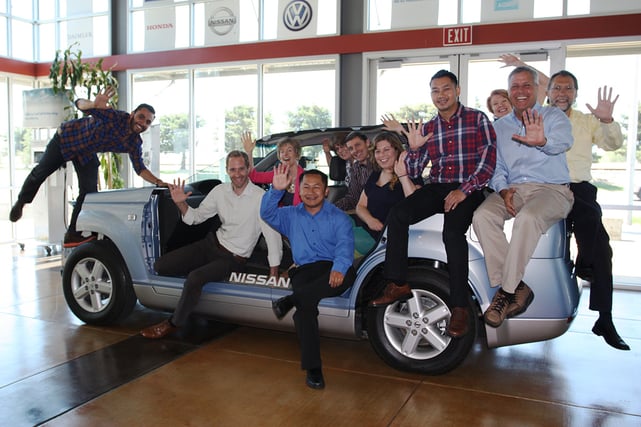 California Fuel Cell Partnership staff
California Fuel Cell Partnership staff
We've initiated the market. It's moving and we need to scale it up and really get it to that tipping point of sustainability. But it won't stop at our border. And we're also looking at more ways to share what we’ve learned.


%20Fuel%20Cell%20Electric%20Trucks%20Analysis%20of%20Hybrid%20Vehicle%20Specifications/WP-thumbnail-fuel-cell-electric-trucks.png?width=105&name=WP-thumbnail-fuel-cell-electric-trucks.png)

